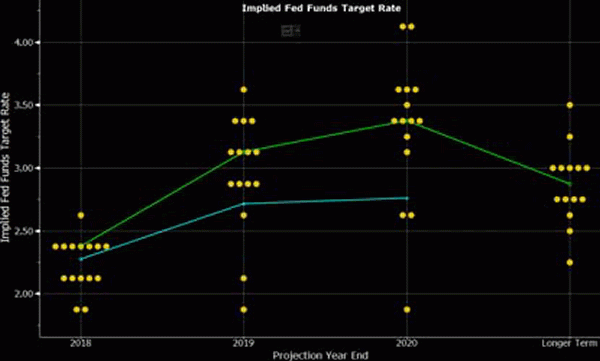Fed hikes policy rate by 25 bps to 1.75%-2% New dot plot shows 1 additional rate hike in 2018 and 2019 FOMC statement drops accommodative guidance; 4 hikes away from neutral Muted market reaction: US curve bear flattens, dollar unchanged, stocks lower Powell introduces press conferences after every meeting, starting next year
The Fed hiked its policy rate as widely anticipated by 25 bps from 1.50%‐1.75% to 1.75%‐2%. The decision was unanimous. The balance sheet run‐off (currently $30bn/month) goes according to plan. The issue that it puts pressure on emerging markets especially in combination with higher US budget deficits, as raised by RBI governor Patel last week, wasn’t touched upon.
Fed Chairman Powell confirmed that the US economy is doing very well and the outlook remains favourable. Unemployment and inflation are low and the Fed reached its dual mandate of maximum unemployment and price stability. In its statement, the Fed upgraded its language on economic activity (“solid rate”), unemployment (“declined”), household spending (“picked up”) and investments (“continued to grow strongly”). Fresh growth forecasts remained unchanged though compared with three months ago for 2019 (2.4%), 2020 (2.1%) and the longer run (1.8%). This year’s median increased to 2.8% from 2.7%. Fiscal stimulus is expected to continue to play an important role. Powell acknowledged for the first time that the trade conflict is a rising risk, but it isn’t in the numbers yet.
Turning to the job market, the Fed expects it to remain strong. The path for the projected unemployment rate was downwardly revised from 3.8% in 2018, 3.6% in 2019 and 3.6% in 2020 to 3.6%, 3.5% and 3.5%. The NAIRU forecast was unchanged at 4.5%. Powell clearly mentioned that payrolls levels we’ve witnessed the past years are unsustainable in the near future. The labour market will continue to strengthen at lower payrolls growth levels.
The inflation path faced an upward revision to 2.1% in 2018, 2019 and 2020, coming from 1.9%, 2% and 2.1% respectively. Price developments are encouraging, but it’s too early to declare victory yet. Inflation is expected to remain above the Fed’s 2% target in the foreseeable future, but the FOMC will look through this transitory effect which mainly stems from higher oil prices. Powell stressed on multiple occasions that the Fed’s inflation target is symmetric, suggesting no willingness to step up the tightening cycle because of a temporary overshoot.
Neutral policy stance by mid-2019?!
The upbeat economic assessment triggered marginal, but significant changes to the FOMC’s new dot plot. One governor raised his forecast for this year from a total of 3 rate hikes to 4. Given the tight call in March, it proved to be sufficient to raise the median FOMC forecast from 2.125% to 2.375%, indicating two more rate hikes this year, probably in September and December. The median FOMC projections for 2019 increased as well, from 2.875% to 3.125% (3 hikes in 2019) after two governors lifted their dot compared to March. The 2020 median forecast (3.375%) and the one for the long term neutral rate (2.875%) remained unchanged. The latter remains very sensitive to upward revisions though with 7 governors thinking the neutral rate is higher and 7 who believe it is lower.
Powell said at the press conference that we’re 4 rate hikes away from a neutral rate. That’s why the FOMC decided to drop its crisis‐introduced forward guidance on rates. “The Federal Funds rate is likely to remain, for some time, below levels that are expected to prevail in the longer run” no longer features in the statement. Powell warned for the risk of rising rates too slowly and the risk of rising them too rapidly. We think that the Fed will continue raising its policy rate on a quarterly basis between now and June next year, consistent with the sustained expansion of economic activity, strong labor market conditions and inflation near the Committee’s symmetric 2% objective over the medium term.
New Fed dot plot (green) and Fed Funds future curve (blue): increase of 2018 and 2019 projections
Powell showed some hesitation when asked what the Fed would do once the neutral stance was reached. The 2020 forecast suggests no strong willingness to turn very restrictive (yet). He said that wide uncertainty remains around what the neutral rate and NAIRU will be and kept all options open. Incoming data on labour markets and inflation will be closely watched, as will other financial variables. Fed Chairman Powell will hold a press conference after every FOMC meeting from January 2019 onwards to enhance communication to markets.
Overall, we conclude that the Fed turned again somewhat more hawkish compared to March 2018. We are pleased to see that the median Fed funds rate forecast is now in line with our own forecasts (4 hikes this year). Bar substantial deviations from the Fed’s current scenario, we think that the dots won’t materially change again in 2018. Only the neutral rate forecast is probably subject to potential changes, eg when soon to be confirmed Washington‐based Fed governors Clarida and Bowman join the FOMC.
All in all muted market reaction
The hawkish changes to the dot plot and statement initially triggered the traditional reactions. US yields increased, bear flattening the curve. The US 10‐yr yield tested the psychological 3% mark, but failed to sustain above. The dollar gained ground, but soon returned to pre‐ FOMC levels. EUR/USD closed around 1.1785. Today’s ECB meeting probably explains some of the cautiousness, with the central bank expected to take the next step in its early normalization process. US stock markets lost 0.1% to 0.4%.













